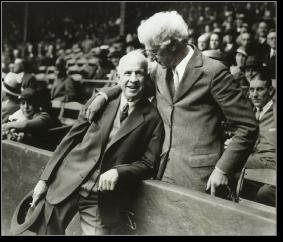
Sport: Baseball
Born: October 26, 1866
Died: January 2, 1933
Town: Camden, New Jersey
William J. Gleason was born October 26, 1866, in Camden, NJ. His time in New Jersey was relatively short; the family moved across the Delaware and north into the coal mining region of the Pocono Mountains when he was just a boy. He and his five brothers—including Harry Gleason, who played in the majors in the early 1900s—all did time as coal-crackers, working alongside the elderly and injured for a few pennies an hour. Short and skinny, Bill Gleason acquired the nickname “Kid” after entering pro ball at age 19.
Kid Gleason was a pitcher who could play almost any position when he wasn’t on the mound. This versatility earned him some acclaim in the minor leagues. In 1888, Kid got a tryout with the National League Quakers (now the Phillies) and made the club as a pitcher. He had limited success, but with the formation of the Players League in 1890, he had a chance to leave the Quakers for more money. Kid stayed loyal to manager Harry Wright and remained in Philadelphia. He was summarily booted out of the Brotherhood, the early players union formed by John Ward.
The decision, however, turned out to be a smart one. With many stars having left the NL, Kid mowed down the leftovers, winning 38 games and racking up 506 innings pitched in 1890. When the Players League folded in 1891, his win total dropped to 24. Naturally, Philadelphia showed less loyalty to Kid in 1892, trading him to St. Louis. He held his own, topping 20 wins in each of the next two seasons.
In 1894, Kid was sold to the Baltimore Orioles, a team noted for both its immense talent and larcenous spirit. Under manager Ned Hanlon, Kid continued to be a consistent winner and also hit .349 as the Orioles won the pennant. In 1895, Hanlon decided to make Kid an everyday infielder. He hit over .300 again and Baltimore won another pennant.
Kid’s next stop was the New York Giants. He played second base for the team and had a career year in 1897, batting .316 with over 100 RBIs. In New York, Kid’s baseball acumen was on display as team captain. He proved a good leader and strategist, and is credited with devising the intentional walk. Kid also encouraged his teammates to work out in the offseason. He himself hit the gym in the winter, staying in shape well into his 30s—an age when most ball players ate, drank or caroused their way out of the game.
Kid played for the Tigers and Phillies, plus a few seasons in the minors, before returning to the majors as a coach with the White Sox in 1912. He got into a game and actually got a hit at age 45. The White Sox built a formidable club, winning the 1917 pennant. In 1919, Kid was promoted to manager.
The 1919 club cruised to the pennant. But after losing the opening game of the World Series to the overmatched Reds, Kid grew suspicious that some of his players were laying down. He accused the losing pitcher, Eddie Cicotte, of throwing the game in front of more than 100 witnesses in the lobby of the team’s hotel that night. The Reds won the series and, toward the end of the 1920 season, the Black Sox scandal broke. Kid was beyond reproach, but he suffered nonetheless, as he was left with a gutted ball club. His final year at the helm came in 1923.
In 1925, Connie Mack hired Kid as a coach with the Philadelphia Athletics. He helped the A’s build a three-time pennant-winner from 1929 to 1931. Alas, Kid was no kid anymore. He retired for good from baseball after the 1931 World Series at the age of 65. A widower, he moved in with his daughter in Philadelphia and died just over a year later of heart failure. More than 5,000 people attended his funeral.